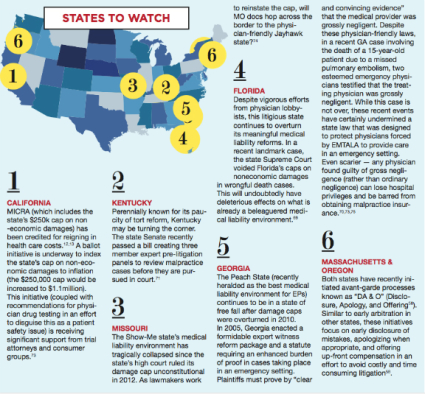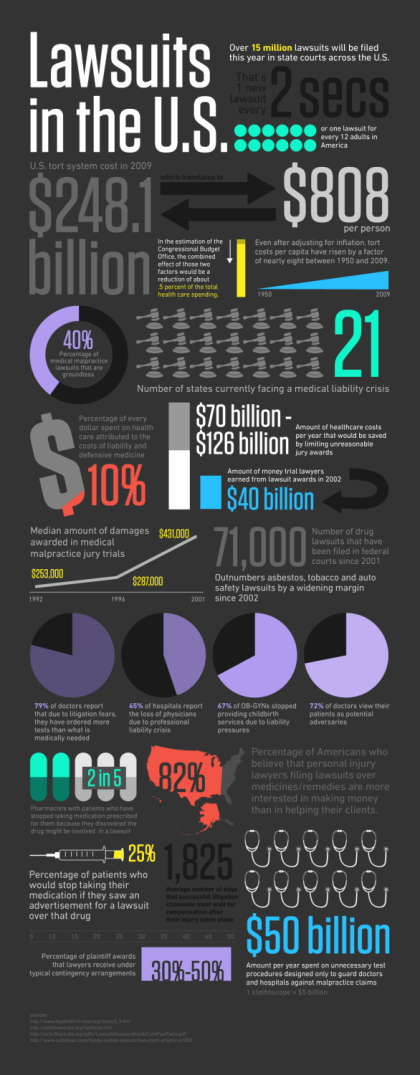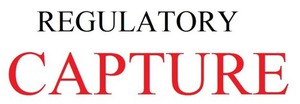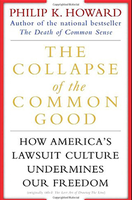............................... Defensive Medicine ..................................
Defensive medicine
Wikipedia
Defensive medicine, also called defensive medical decision making, refers to
the practice of recommending a diagnostic test or medical treatment that is not necessarily the best option for the patient, but an option that mainly serves the function to protect the physician against the patient as potential
plaintiff. Defensive medicine is a reaction to the rising costs of malpractice insurance premiums and patients’
biases on suing for missed or delayed diagnosis or treatment but not for being overdiagnosed. U.S. physicians are at highest risk of being sued, and overtreatment is common. The number of lawsuits
against physicians in the USA has increased within the last decades and has had a substantial impact on the behavior of physicians and medical practice. Physicians order tests and avoid treating
high-risk patients in order to reduce their exposure to lawsuits, or are forced to discontinue practicing because of overly high insurance premiums.[1] This behavior has become known as defensive
medicine, "a deviation from sound medical practice that is indicated primarily by a threat of liability." Read
more
Medical malpractice in the United States
Medical Malpractice in the United States
Wikipedia
Medical malpractice is professional negligence by act or omission by a health care provider in which the treatment provided falls below the accepted standard of practice in the medical community and causes injury or death to the patient, with most cases involving medical error.[1] Claims of medical malpractice, when pursued in US courts, are usually processed as civil torts, but are sometimes subject to criminal procedures, as in the case of the death of Michael Jackson. Medical professionals may obtain professional liability insurances to offset the costs of lawsuits based on medical malpractice. Further establishment of conditions of intention or malice may be applied where applicable.[2] Read more
The Medical Malpractice Rundown: A State-by-State Report Card
When it comes to medical liability laws and culture, where you live matters. Depending on your state, your liability and premiums might be sky high or totally reasonable.
Find out how your state stacks up against the other 49. Read more
The Fallacies of Medical Malpractice "Tort Reform" (PDF)
by Alan H. Figman '82
Figman & Epstein, LLP
Organizations representing the state’s doctors and their insurers have been hard at work trying to convince the public that medical malpractice insurance premiums have escalated beyond affordability due to medical malpractice lawsuits, resulting in increasing healthcare costs and in physicians leaving New York. Hospital associations claim their industry needs relief from the high cost of malpractice coverage. Legislators are constantly lobbied by these groups, being told that malpractice litigation results in "defensive medicine" and that "frivolous" lawsuits result in "soaring" liability payments that drive up the cost of healthcare.
The fact is, healthcare costs are not driven by litigation. The inconvenient truth is that they are a result of epidemic levels of medical error and the economics of the healthcare industry.
Figman.FallaciesOfMedMalTortReform.pdf
Adobe Acrobat document [150.2 KB]
Defensive Medicine: A Bane to Healthcare
National Institutes of Health
By M Sonal Sekhar and N Vyas
Ann Med Health Sci Res.
2013 Apr-Jun; 3(2): 295–296.
doi: 10.4103/2141-9248.113688
Sir,
"I will prescribe regimen for the good of my patients according to my ability and my judgment and never do harm to anyone"
The above oath is what every physician is bound to follow, but what happens in real practice is quite alarming. The so-called divine profession has lost its glory due to the intrusion of an evil namely ‘defensive medicine.’ Defensive medicine in simple words is departing from normal medical practice as a safeguard from litigation. It occurs when a medical practitioner performs treatment or procedure to avoid exposure to malpractice litigation. Defensive medicine is damaging for its potential to poses health risks to the patient. Furthermore, it increases the healthcare costs. Not the least, defensive medicine also paves way for degradation of physician and patient relationship.[1] Read more
National Institutes of Health
Defensive Medicine_ A Bane to Healthcare[...]
Adobe Acrobat document [44.5 KB]
Tort Reform Hasn’t Worked. New Study proves none of the touted benefits materialized and it's causing actual harm. Observer
10 Years of Tort Reform in Texas Bring Fewer Suits, Lower Payouts. Sep 3, 2013
Supporters of the "tort reform" law say doctors worry less about being sued and have seen their malpractice insurance premiums fall.
Does tort reform affect physician supply[...]
Adobe Acrobat document [2.3 MB]
The Health Care and Tort Reform Debate. By David Goguen, J.D., University of San Francisco School of Law. Tort reform efforts have yet to yield legislation at the federal level, but a number of states have passed laws that make it a little harder for potential plaintiffs to file a medical malpractice lawsuit.
New Directions in Medical Liability Reform
Allen Kachalia, M.D., J.D., and
Michelle M. Mello, J.D., Ph.D.
New England Journal of Medicine, April 21, 2011
New England Journal of Medicine, April 21, 2011
New Directions in Medical Liability Refo[...]
Adobe Acrobat document [469.6 KB]
PBS: Could malpractice reform save the U.S. health care system?
By Sarah Corapi, January 6, 2014
A new essay in the
journal Health Affairs proposes that tackling tort reform on the federal level could convince doctors to agree to bigger changes in the U.S. health care system. In 2013, an article in the Journal
of Patient Safety estimated that between 210,000 to 400,000 people die every year in the U.S. from hospital medical errors. Read more
A_New,_Evidence_based_Estimate_of_Patien[...]
Adobe Acrobat document [252.8 KB]
Medical Malpractice And Tort Reform In The Southeast: It Appears to Have Worked, Southeastern Journal of Legal Studies
Southeastern Journal of Legal Studies
Medical Malpractice And Tort Reform In T[...]
Adobe Acrobat document [113.9 KB]
Hippocratic Oath
Wikipedia
The Hippocratic Oath is an oath historically taken by physicians. It is one of the most widely known of Greek medical texts. In its original form, it requires a new physician to swear, by a number of healing gods, to uphold specific ethical standards. Of historic and traditional value, the oath is considered a rite of passage for practitioners of medicine in many countries, although nowadays various modernized versions are often used; the message delivered is still the same: do no harm.
Hippocrates is often called the father of medicine in Western culture.[1] The original oath was written in Ionic Greek, in the late Fifth Century BC.[2] It is usually included in the Hippocratic Corpus.
Scholars widely believe that Hippocrates or one of his students wrote the oath between the 5th and 3rd century BC.[3] Alternatively, classical scholar Ludwig Edelstein proposed that the oath was written by the Pythagoreans, an idea that others questioned for lack of evidence for a school of Pythagorean medicine.[4] Read more
Remarks by President Obama to a Joint Session
of Congress on Health Care Reform
Remarks by the President to a Joint Session of Congress on Health Care
September 9, 2009
"Now, finally, many in this chamber -- particularly on the Republican side of the aisle -- have long insisted that reforming our medical malpractice laws can help bring
down the cost of health care. (Applause.) Now -- there you go. There you go. Now, I don't believe malpractice reform is a silver bullet, but I've talked to enough doctors to know that defensive medicine may be contributing to unnecessary costs. (Applause.) So I'm proposing that we move forward on a range of
ideas about how to put patient safety first and let doctors focus on practicing medicine. (Applause.) I know that the Bush administration considered authorizing demonstration projects in individual
states to test these ideas. I think it's a good idea, and I'm directing my Secretary of Health and Human Services to move forward on this initiative today. (Applause.)"
Remarks by Pres. Obama to Congress, Heal[...]
Adobe Acrobat document [117.4 KB]
Most Physicians Will be Sued for Medical Malpractice
Most Physicians Will Be Sued for Medical Malpractice,
Though Payouts Are Few, Study Finds
ABA Journal Law News Now
August 18, 2011
by Debra Cassens Weiss
Most physicians and virtually every surgeon will face a medical malpractice claim at least once in their careers, a study has found.
But only one claim out of five results in a settlement or other payout, the Associated Press and the Boston Globe report. Neurosurgeons and heart surgeons are sued the most, while
pediatricians and psychiatrists are sued the least. Across specialties, the average indemnity payment was about $275,00 and the median was about $112,000.
The study, published in the New England Journal of Medicine, analyzed medical malpractice
data from a national insurer for the years 1991 to 2005. "Our study uncovered an important aspect of malpractice liability: the high likelihood of claims that do not result in payments to a
plaintiff," the authors write. Yet physicians consistently report concerns about malpractice claims, "suggesting that the risk of being sued alone may create a tangible fear among
physicians."
One of the study authors is economist Amitabh Chandra, a public policy professor at the Harvard Kennedy School of Government. He said the study highlights the need to
resolve med-mal disputes before litigation. "In some sense, the payment is the least important part, because you can insure against it, but you can’t insure against the hassle cost," Chandra told the
Globe.
Malpractice Risk According to Physician Specialty
Malpractice Risk According to Physician Specialty
The New England Journal of Medicine
August 18, 2011
N Engl J Med 2011; 365:629-636
Background: Data are lacking on the proportion of physicians who face malpractice claims in a year, the size of those claims, and the cumulative career malpractice risk
according to specialty.
Results: Each year during the study period, 7.4% of all physicians had a malpractice claim, with 1.6% having a claim leading to a payment (i.e., 78% of all claims did not
result in payments to claimants). The proportion of physicians facing a claim each year ranged from 19.1% in neurosurgery, 18.9% in thoracic–cardiovascular surgery, and 15.3% in general surgery to
5.2% in family medicine, 3.1% in pediatrics, and 2.6% in psychiatry. The mean indemnity payment was $274,887, and the median was $111,749. Mean payments ranged from $117,832 for dermatology to
$520,923 for pediatrics. It was estimated that by the age of 65 years, 75% of physicians in low-risk specialties had faced a malpractice claim, as compared with 99% of physicians in high-risk
specialties. Read more
New England Journal of Medicine
Malpractice Risk According to Physician [...]
Adobe Acrobat document [725.9 KB]
Lawsuit-wary docs drive up costs with unneeded tests
Lawsuit-wary docs drive up costs with unnecessary tests
Tampa Bay Times
by Susan Taylor Martin
October 3, 2009
Ed Homan, an orthopedic surgeon in Tampa, often sees patients complaining of knee pain. Based on a $40 X-ray and his 40 years of experience, he can usually tell if it is
only a sprain.
But there's also a remote chance the pain is caused by a malignant tumor. Rather than risk being sued for a wrong diagnosis, Homan may order an $800 CT scan.
"You want to make sure you don't make any mistakes," he says. "There's a question of where the line is between very thorough, good medicine and where it becomes defensive
medicine."
Concern over the nation's soaring health care costs has increasingly focused on defensive medicine — unnecessary tests, procedures, referrals and consultations ordered by
physicians who are afraid of being slapped with lawsuits.
"I've talked to enough doctors," President Barack Obama said in his recent speech to Congress, ''to know that defensive medicine may be contributing to unnecessary
costs." Read more
Tampa Bay Times, by Susan Taylor Martin
Lawsuit-wary docs drive up costs with un[...]
Adobe Acrobat document [83.3 KB]
Personal Injury Lawyer Billboard Battle
Female-Owned Personal Injury Law Firm Sparks Billboard Battle in Detroit
ABA Journal Law News Now
by Martha Neil
August 8, 2011
Television is still a major advertising medium for personal injury lawyers in and around Detroit. But a relatively new and unusual competitor has sparked a growing
billboard battle in recent years.
Operating what she says is the first PI firm in the state headed by a woman, 47-year-old Joumana Kayrouz promoted her law practice on dozens of billboards, forcing male
competitors to do the same, reports the Free Press.
"She came out of nowhere with a very unique idea," says prominent PI attorney Vernon Johnson of Kayrouz. "Because of her success, you see the big hitters doing the same.
She's done a great job."
Local billboard companies say their business has increased as a result of all the attorney faces and catchy phone numbers plastered around town, although some of the
principal competitors, including Kayrouz, deny they're advertising in reaction to one another.
Typical billboards include a lawyer's name, photo and a catchy phrase to help viewers remember the phone number to call. But one attorney has become so well-known from
his "call Sam" television commercials that his billboard simply shows his photo in place of the final digits of his phone number. Read more
America, The Lawsuit-Happy Nation
Infographic: America, The Lawsuit-Happy Nation
Zero Hedge
by Econmatters
August 27, 2011
According to the latest BLS national wage estimate through May 2010, the mean annual salary for lawyers was around $129,440, which partly accounts for the fact that
the U.S. has one of the highest number of lawyers per capita in the world.
Based on data from the American Bar Association, there are over 1.2 million lawyers in the United States. That's one attorney for every 254 Americans, which also makes
some of the stunning statistics (and what a waste of resources) illustrated in the infographic below somewhat "logical":
- 15 million lawsuits will be filed in 2011 across the U.S.
- A new lawsuit every 2 seconds
- One lawsuit for every 12 adults
- 21 U.S. states are facing a medical liability crisis
- $248.1 billion = the cost to the U.S. tort system (personal injury) in 2009, or $808 per person
- The cost per capita of tort related lawsuits has increased 800% between 1950 to 2009
The Great Recession may have diminished the ability of lawyers to command a higher salary, but probably at the same time also has increased the likelihood of frivolous litigation, as the odds are good for some kind of settlement to avoid an even more costly trial, particularly when insurance companies are involved. Read more
















































































































































